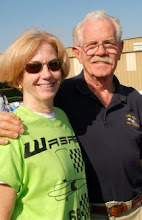by Elliot Seguin
 |
| Darryl’s F-104 at Mojave |
Full burner at an average speed of 988 mph, 200 feet agl for four passes. A homebuilt aircraft attempting to topple a record set on a military budget. Darryl had built his F-104 out of parts he had found painstakingly searching junk yards across the country; this took him 13 years. All systems unnecessary for the attempt were removed and fuel bags replaced them, giving him 1,050 gallons of Jet A for the attempt (typical standard load is 850 gal). He landed with 50 gallons remaining; the fuel he had consumed in the 20 minute record setting flight could, if burned at altitude, have powered his jet halfway across the country. The airplane was assembled in Van Nuys, but was not permitted to fly from there so Darryl trucked it to Mojave for the initial flight test. When the airplane was destroyed after a gear problem, the wreckage sat here in the Mojave bone yard until the late 80’s when it was finally scrapped. Al Hansen purchased the airplane after the crash trading a semi truck to Darryl for the wreckage.
 |
| Darryl’s 104 during a record setting pass. |
The 3km record is historically the absolute speed record in aircraft. Measured as the average speed of four passes two in each direction over a 3km course the format for the record was developed over many years. Initially the speed record was more of a VNE record with pilots diving onto the course from greater and greater altitudes. This was finally controlled by limiting the max altitude that could be reached during an attempt. The current rules state that the aircraft cannot exceed 100 meters AGL during the run and 500 meters AGL during the turns. However, as the speed of aircraft has increased since the introduction of the jet age the danger associated with flight at these altitudes has increased substantially. Between 1953 and 1955 a lull in speed record setting was attributed to this extreme risk. Fortunately, new timing cameras were developed for flight test of aircraft at high altitude (they were tested here in the Antelope Valley at Edwards). These cameras were eventually certified by the FAI for speed record setting. Starting in 1955 the 15/25km closed course record was opened up to all altitudes, this became the new realm of the absolute speed record. Typically American records were set here at the Mint Canyon Speed Course (an 11.25 mile speed course set up from Palmdale airport south towards LA). An image conscious military took advantage of this risk reduction and focused on high altitude records until the Navy started on it’s Sageburner program.
 |
| Sageburner YF4H-1F (Navy Photo) |
The Sageburner program was an effort by the US Navy to probe the extents of the low altitude speed envelope in a modified YF4H-1F. After 5 years of high altitude speed envelope expansion the 3km record had become very attainable. The initial F-4 the navy had prepared for the attempt was destroyed after a pitch damper problem resulted in a violent PIO during a low level speed run that broke up the airplane (apparently sending flaming engines several miles down range). Despite losing the aircraft and pilot (Commander J.L. Felsman) the Navy continued with the program adding a second pilot to observe in the terribly dangerous environment. The record was finally set on 8-28-61 at a speed of 902 mph by Lt. Hunt Hardesty. There is a rumor that the very low time engine that Darryl used to set his record was loaned to the effort by the Air Force specifically to embarrass the Navy’s Sageburner effort (not much worse than being beat by “civies”).
 |
| Darryl on the course |
 |
| The 104 wreckage here at Mojave (Scaled Composites van in Background) (David Lednicer) |
During an otherwise successful test flight for the newly installed water injection system, he did a low pass for the crew here at Mojave. With twenty minutes of gas remaining threw out his gear to start the approach into Mojave. He looked down to see that only his nose gear and right main were indicating down and locked. He flew to Edwards where he set the airplane on the runway to see if the gear felt solid. Lightly touching the airplane down on the mains at Edwards he found the airplane rolled to the left as he put weight on the gear and the Edwards tower said it looked like it was trying to collapse. Darryl had no choice but to abandon the airplane. He climbed up to 10,000 feet over the Edwards bombing range shut down the engine and ejected. He watched as the airplane flew away from him and then turned back underneath him finally going out of sight below him in the desert. The airplane was destroyed and Darryl was forced to abandon the project. The Russian altitude record he was setting out to beat still stands.
 |
| The E-266M (MIG 25M) Absolute altitude record holder (Photo: Paul Nann) |
The Lockheed F-104 was in production for 30 years from 1954 through 1983. They were removed from active USAF service in 1969. The last operational F-104s were retired from the Italian AMI in 2004. The aircraft is powered by a J79 afterburning turbo jet engine (the same engine that fired the F-4 Sageburner whose record Darryl toppled). The aircraft was designed for peak efficiency at mach 1.6, and the airframe was limited to Mach 2.2(over-temperature of aluminum structure). Early examples featured downward ejection for fear of the t-tail slicing an ejecting pilot in two. Darryl's 104 wreckage remained in Mojave until the late 80's when it was finally scrapped, a few pieces remain, but most importantly the record still stands, under civilian registration. What are you working on tonight?
Berliner, Don. Victory Over The Wind. New York: Van Nostrand Reinhold Co. Inc, 1983.
Davidson, Keith. Record Lists/Racing & Record Aircraft Special Interest Group International Plastic Modellers’ Society. Dec 31, 2006. IPMS.org
Fédération Aéronautique Internationale,"FAI Sporting Code” Section 2-Aeroplanes. Lausanne Switzerland, January 2010


















